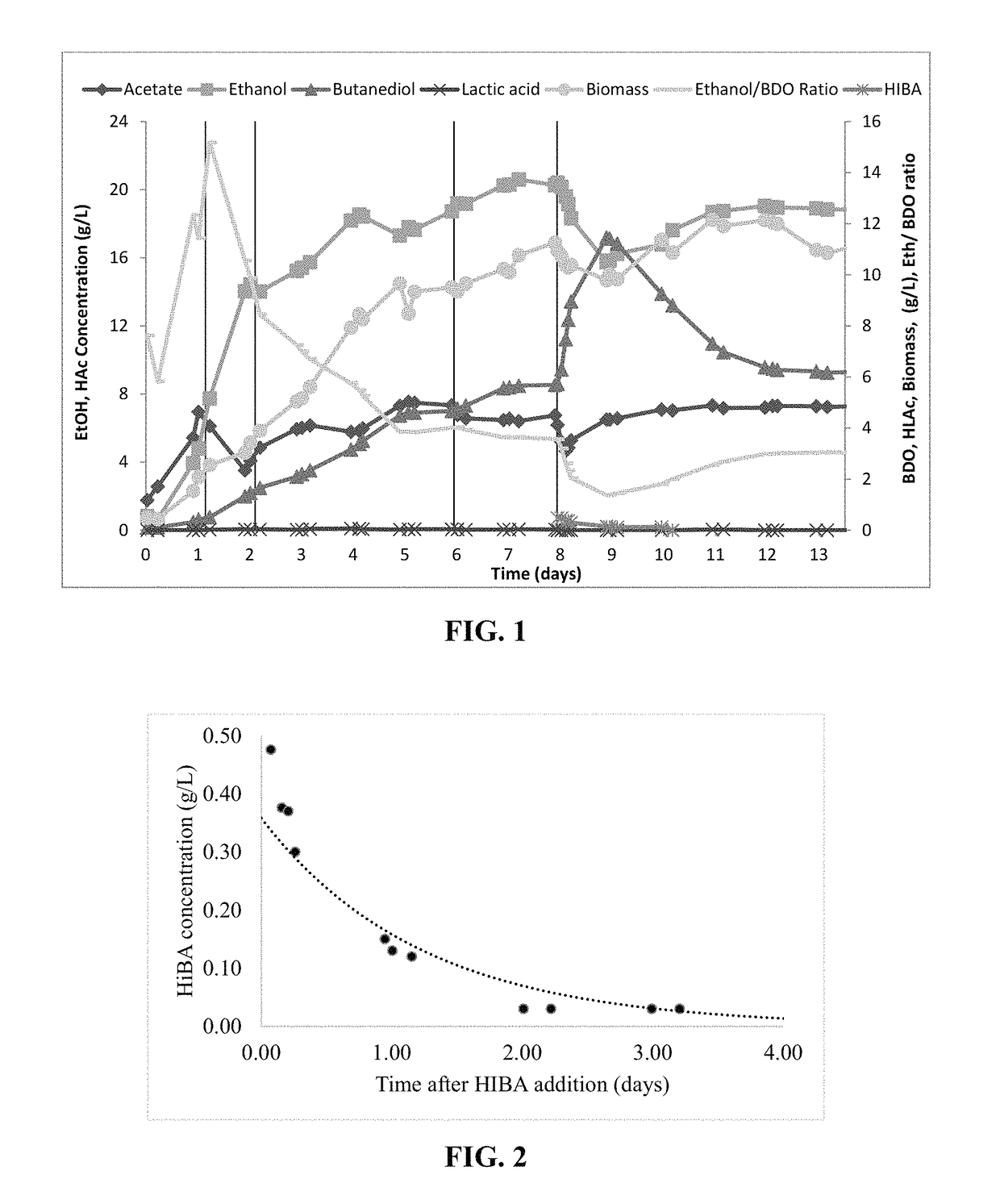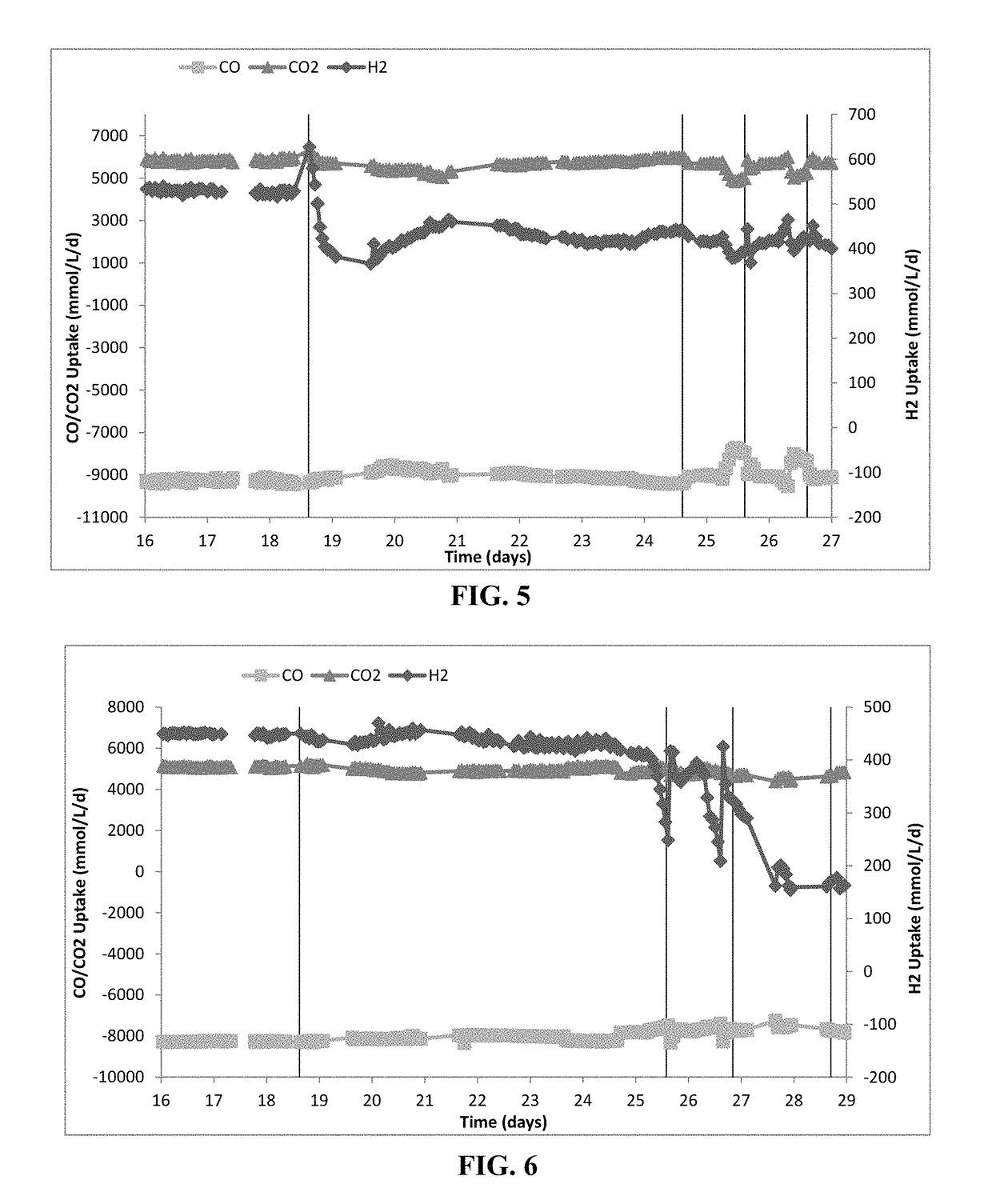Fermentation process
a technology of fermentation process and metabolite, which is applied in the direction of transferases, biofuels, fermentation, etc., can solve the problems of reducing the activity of acetolactate, and increasing the cost of industrial plants, so as to reduce the activity of acetolactate, the effect of increasing the production of acetolactate and reducing the activity of the ketol-acid-reductoisomeras
- Summary
- Abstract
- Description
- Claims
- Application Information
AI Technical Summary
Benefits of technology
Problems solved by technology
Method used
Image
Examples
example 1
[0197]The impacts of 2-HIBA were investigated on a single reactor system which had been optimised for 2,3-BDO production. This was done to ascertain the impact that this chemical would have on a high performance system and obtain information on suitable concentrations that would not interfere with overall fermentation stability. 0.5 g / L (4.8 mM) 2-HIBA was added to the fermenter on day 7.95, the results from this addition are shown in FIG. 1. The addition of 2-HIBA altered the metabolite profile of the fermentation increasing the production of 2,3-butanediol whilst decreasing the production of ethanol, acetate and biomass.
[0198]The 2,3-BDO concentration increased from 6 g / L to 12 g / L dropping the ratio from 4:1 to as low as 1.4:1. This addition was shown not to have a detrimental impact on gas uptake although ethanol and biomass concentration decreased as a result of the addition. The concentration of 2-HIBA was monitored in the reactor liquid outflow. The results of this are shown ...
example 2
[0199]A two reactor system was used to examine the impact of continuous 2-HIBA addition on the metabolite profile. Initially 0.5 g / L / day (4.8 mM / day) 2-HIBA was added to the R2 only, this increased the production of 2,3-BDO but the ratio only dropped to as low as 1.9:1. Continuous addition of 2-HIBA at 0.5 g / L / day (4.8 mM / day) was then added to the R1. Because the 2-HIBA is not converted by the bacteria it was hypothesised that addition to the R1 would significantly increase the overall production of 2,3-BDO. This would be achieved by improving the concentration in both the R1 and the R2 as the 2-HIBA is transferred from the R1 to the R2 (through liquid flow) along with improved 2,3-BDO concentrations. The results from this continuous addition are shown in FIGS. 3-6. The 2,3-BDO concentration increased from 5.7 g / L to 14 g / L in the R1 and from 16 g / L to 21 g / L in the R2 (see FIGS. 3 and 4). The ratio of ethanol:2,3-BDO dropped to 1:1 in the R1 and 1.3:1 in the R2 and remained stable...
example 3
[0203]The results achieved in Example 2 were repeated with the aim to improve the overall titre of 2,3-BDO. In this experiment the 2-HIBA concentration was increased to 1 g / L / day (9.6 mM / day). As with the results achieved in the previous experiment the gas uptake was not negatively impacted and the ethanol:2,3-BDO ratio in the R2 remained stable for a period of seven days at 1.3:1. The 1 g / L / day (9.6 mM / day) addition resulted in an improvement in the overall 2,3-BDO concentration which reached as high as 23.9 g / L (see FIG. 7).
PUM
| Property | Measurement | Unit |
|---|---|---|
| concentration | aaaaa | aaaaa |
| concentration | aaaaa | aaaaa |
| concentration | aaaaa | aaaaa |
Abstract
Description
Claims
Application Information
 Login to View More
Login to View More - R&D
- Intellectual Property
- Life Sciences
- Materials
- Tech Scout
- Unparalleled Data Quality
- Higher Quality Content
- 60% Fewer Hallucinations
Browse by: Latest US Patents, China's latest patents, Technical Efficacy Thesaurus, Application Domain, Technology Topic, Popular Technical Reports.
© 2025 PatSnap. All rights reserved.Legal|Privacy policy|Modern Slavery Act Transparency Statement|Sitemap|About US| Contact US: help@patsnap.com



